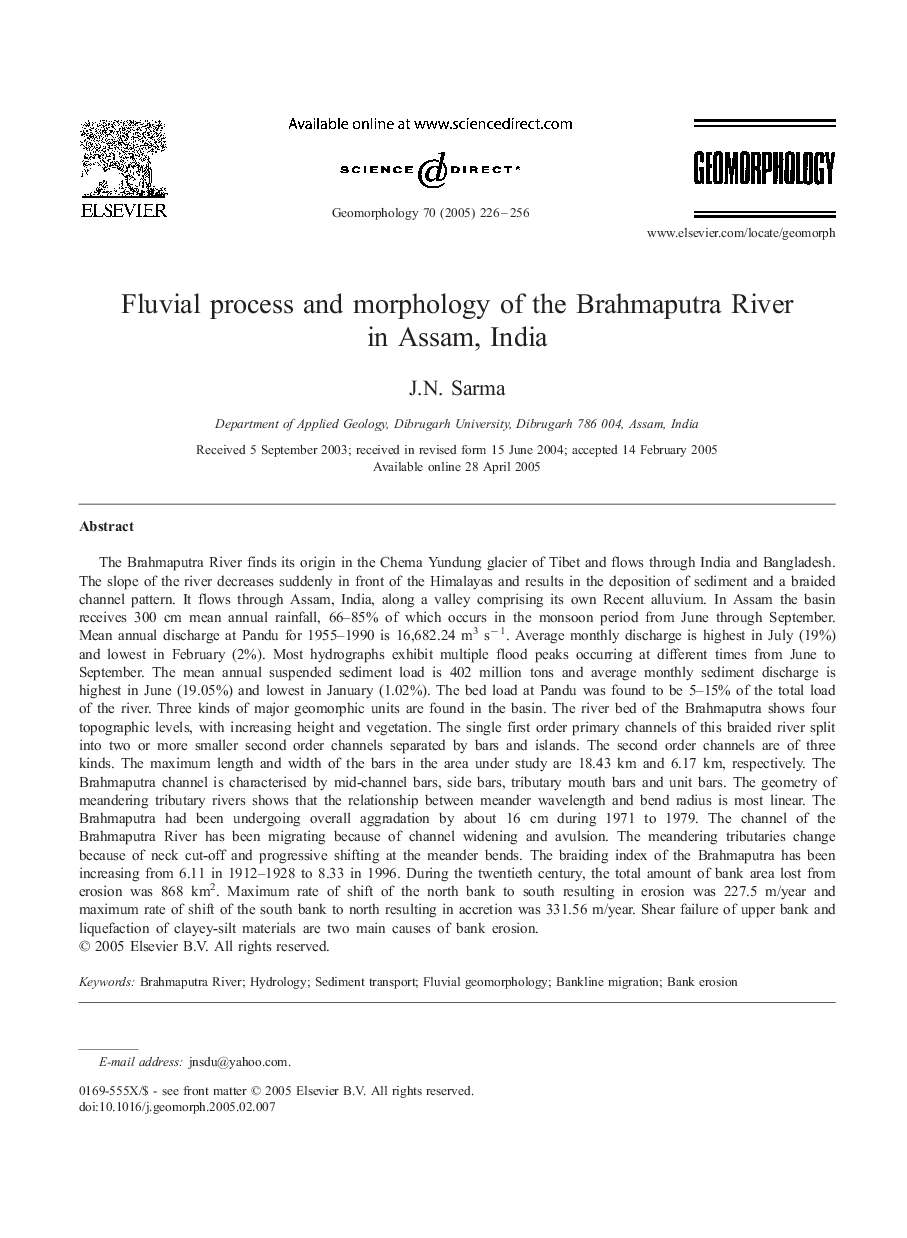| کد مقاله | کد نشریه | سال انتشار | مقاله انگلیسی | نسخه تمام متن |
|---|---|---|---|---|
| 9524820 | 1635609 | 2005 | 31 صفحه PDF | دانلود رایگان |
عنوان انگلیسی مقاله ISI
Fluvial process and morphology of the Brahmaputra River in Assam, India
دانلود مقاله + سفارش ترجمه
دانلود مقاله ISI انگلیسی
رایگان برای ایرانیان
کلمات کلیدی
موضوعات مرتبط
مهندسی و علوم پایه
علوم زمین و سیارات
فرآیندهای سطح زمین
پیش نمایش صفحه اول مقاله

چکیده انگلیسی
The Brahmaputra River finds its origin in the Chema Yundung glacier of Tibet and flows through India and Bangladesh. The slope of the river decreases suddenly in front of the Himalayas and results in the deposition of sediment and a braided channel pattern. It flows through Assam, India, along a valley comprising its own Recent alluvium. In Assam the basin receives 300 cm mean annual rainfall, 66-85% of which occurs in the monsoon period from June through September. Mean annual discharge at Pandu for 1955-1990 is 16,682.24 m3 sâ 1. Average monthly discharge is highest in July (19%) and lowest in February (2%). Most hydrographs exhibit multiple flood peaks occurring at different times from June to September. The mean annual suspended sediment load is 402 million tons and average monthly sediment discharge is highest in June (19.05%) and lowest in January (1.02%). The bed load at Pandu was found to be 5-15% of the total load of the river. Three kinds of major geomorphic units are found in the basin. The river bed of the Brahmaputra shows four topographic levels, with increasing height and vegetation. The single first order primary channels of this braided river split into two or more smaller second order channels separated by bars and islands. The second order channels are of three kinds. The maximum length and width of the bars in the area under study are 18.43 km and 6.17 km, respectively. The Brahmaputra channel is characterised by mid-channel bars, side bars, tributary mouth bars and unit bars. The geometry of meandering tributary rivers shows that the relationship between meander wavelength and bend radius is most linear. The Brahmaputra had been undergoing overall aggradation by about 16 cm during 1971 to 1979. The channel of the Brahmaputra River has been migrating because of channel widening and avulsion. The meandering tributaries change because of neck cut-off and progressive shifting at the meander bends. The braiding index of the Brahmaputra has been increasing from 6.11 in 1912-1928 to 8.33 in 1996. During the twentieth century, the total amount of bank area lost from erosion was 868 km2. Maximum rate of shift of the north bank to south resulting in erosion was 227.5 m/year and maximum rate of shift of the south bank to north resulting in accretion was 331.56 m/year. Shear failure of upper bank and liquefaction of clayey-silt materials are two main causes of bank erosion.
ناشر
Database: Elsevier - ScienceDirect (ساینس دایرکت)
Journal: Geomorphology - Volume 70, Issues 3â4, 1 September 2005, Pages 226-256
Journal: Geomorphology - Volume 70, Issues 3â4, 1 September 2005, Pages 226-256
نویسندگان
J.N. Sarma,